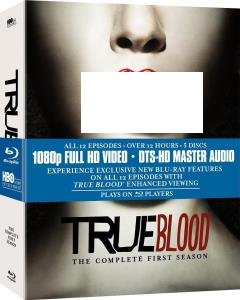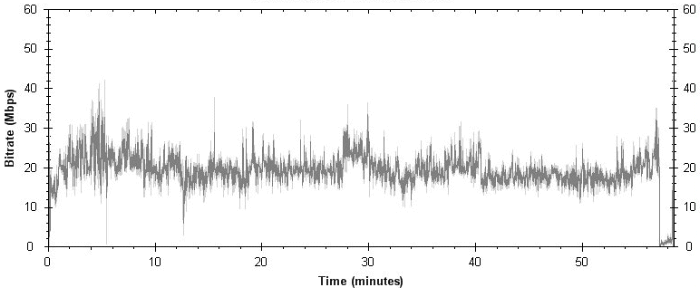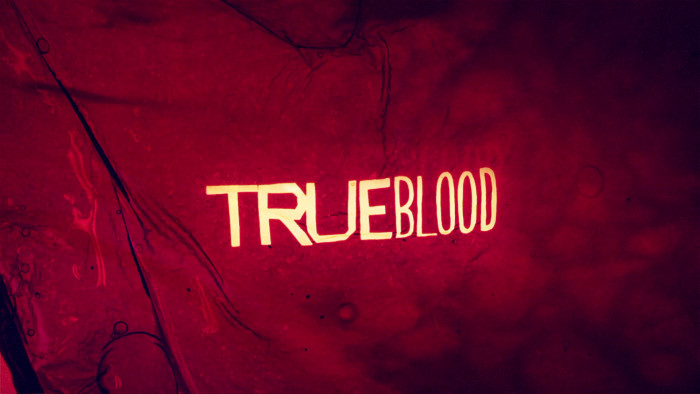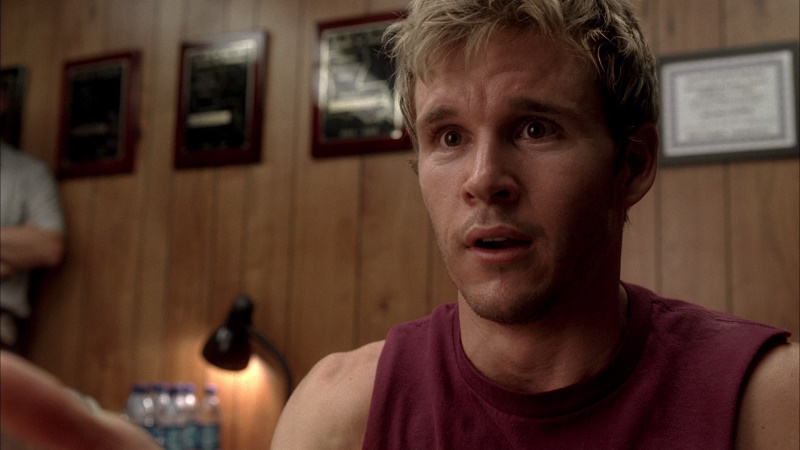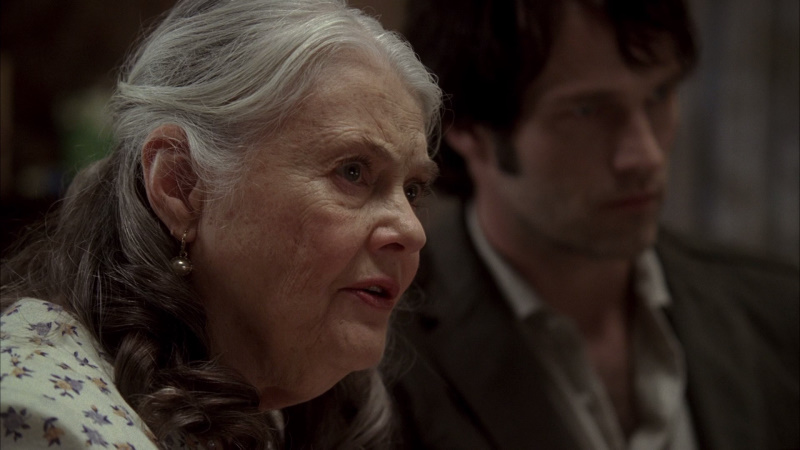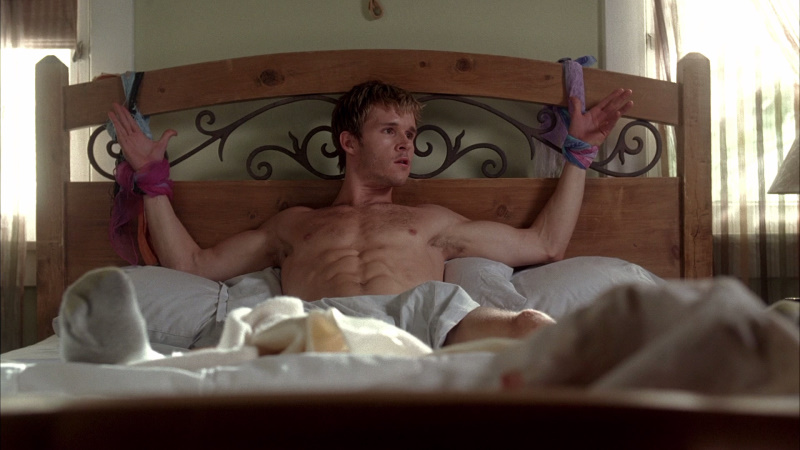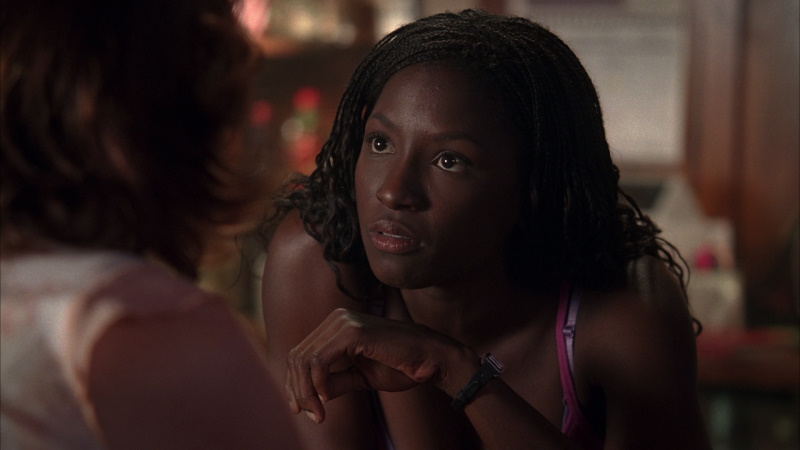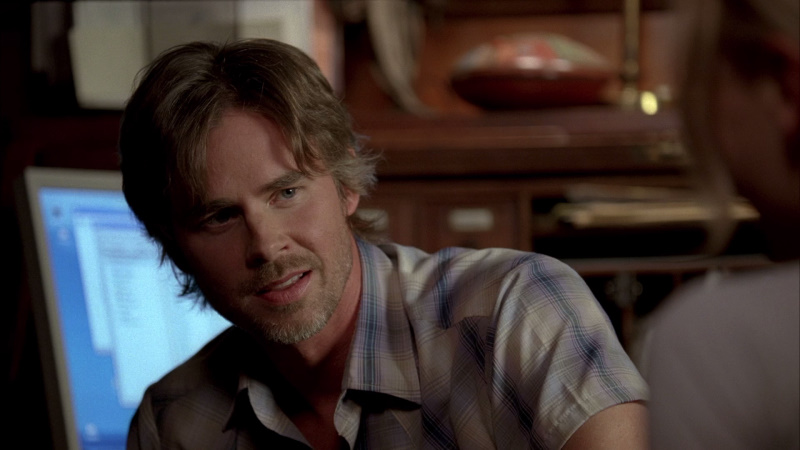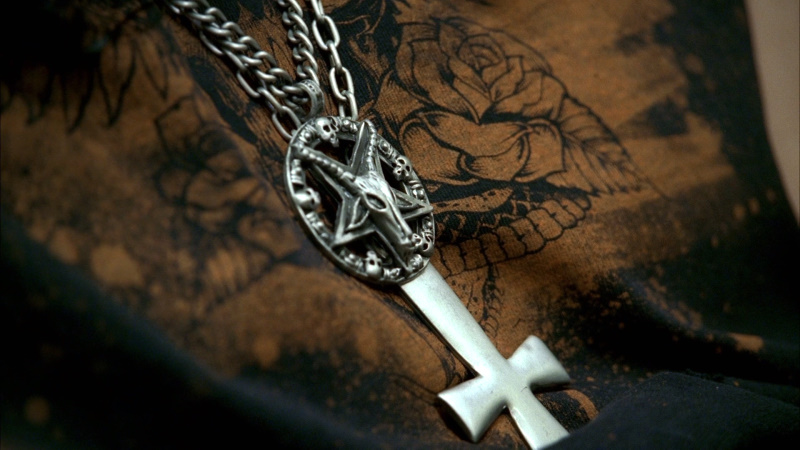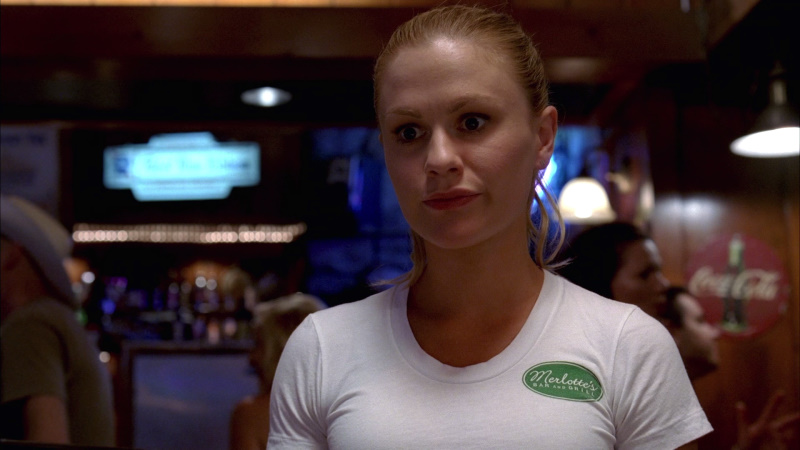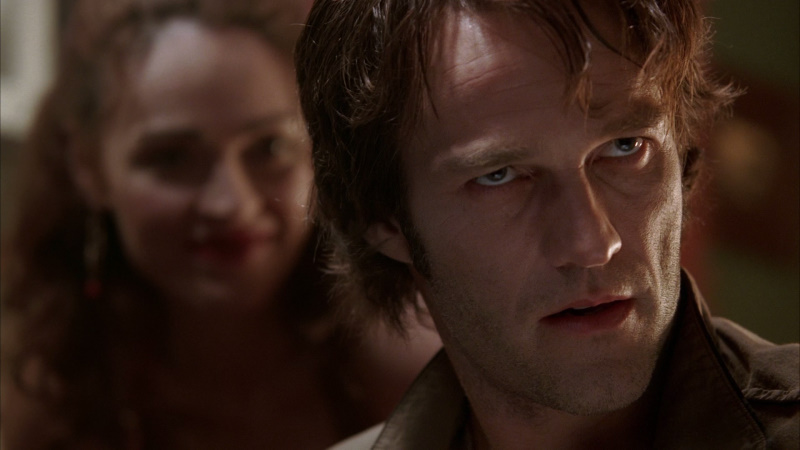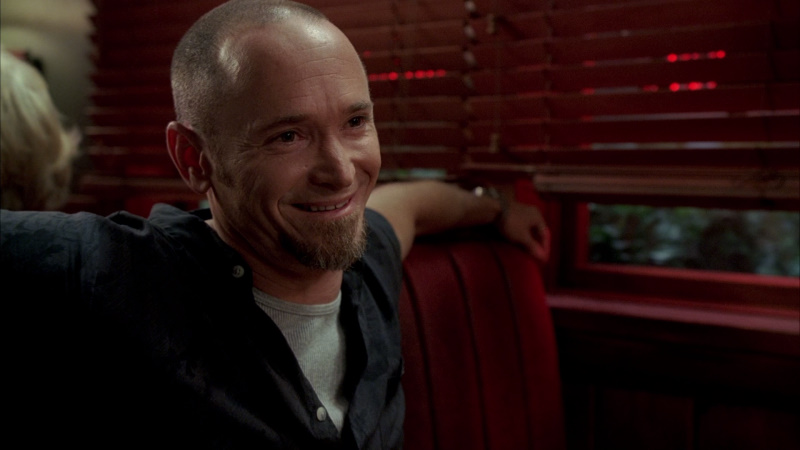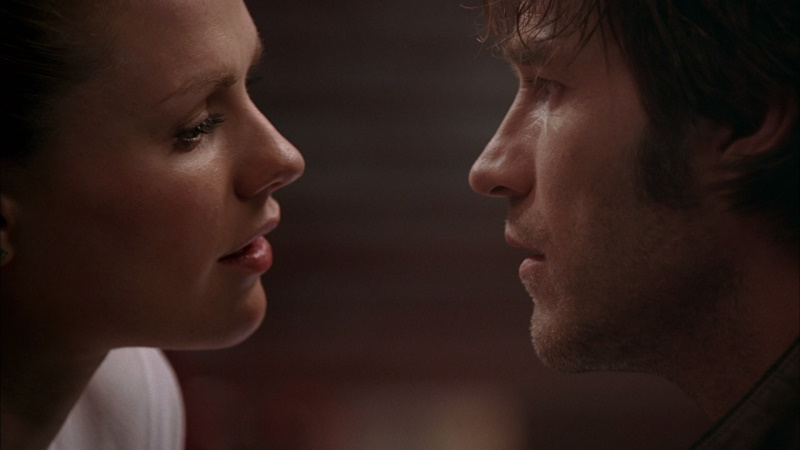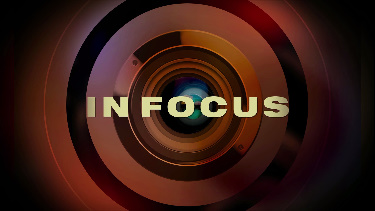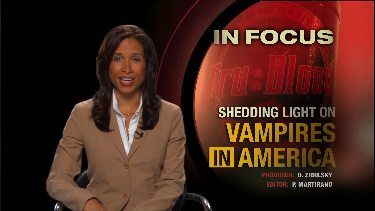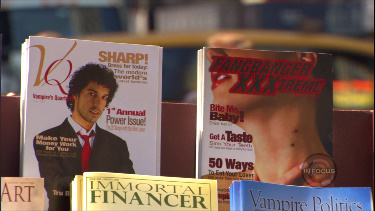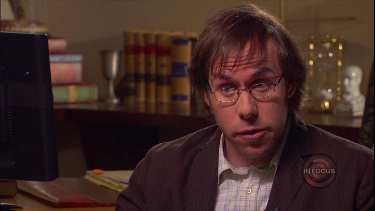Subtitles:
English, French, Portuguese, Spanish, none
Extras:
• 6 Audio Commentaries by Alan Ball, Anna Paquin & Stephen
Moyer, et al
• Enhanced Viewing for all 12 Episodes
• Previews (Next On & Previously On) Spots - in HD
Comment:
HBO's True Blood is based on the Sookie Stackhouse
series of Southern Vampire Mysteries by Charlaine Harris
(which first saw the light of night in 2001, now at book
#10.) Directed by Alan Ball (American Beauty, Six
Feet Under), the series is another and very successful
attempt at re-inventing the vampire mythology – something
like Buffy for adults, with a little X-Men
thrown in for good measure.
True Blood
has more in common with Buffy the Vampire Slayer than
might be obvious from a casual summary of the setup: both
feature a young blonde heroine with special powers who have
a bi-polar thing for vampires. They are disturbingly
attracted to and are properly repulsed by them. They feel
that only the vampire understands them and, in a very
special way, can only be at peace in their presence – at
least as far as males are concerned.
"Buffy" "Sookie" – names that seem more appropriate for a
pet rottweiler than to an actual person, let alone a hero or
a protagonist hoping to hold our interest. Buffy is
recruited by a mythology and an agency to rid the world of
evil. She has the guidance of a "Watcher" who mentors her
in the lore of the demons she will face and in the arts of
offense and defense. Buffy is instructed into the ways of
the vampire not only by her Watcher, but by Angel, a vampire
that appears to have good intentions. Angel is also her
protector, at least at first, showing up in moments of
peril. Ditto: Bill for Sookie.
Pulling the girls in a contrary direction is sex, something
that Buffy resists acknowledging (which makes sense
considering her mission is to kill them, not to sleep with
them) but which Sookie is drawn to from the start. Buffy
learns only too late that sex reveals the monster underneath
– every girl's and every woman's nightmare. Sookie
understands this possibility only too clearly, yet she finds
herself unable to resist the pull that Bill Compton has for
her.
Buffy resists not only her calling, but the consequences of
what it will necessarily do to her social life. She
confides in very few friends, confessing her new life to her
mother more than a year after she takes it on. Sookie, on
the other hand, while a likeable enough young woman, has
always been seen as a little odd. Her telepathic abilities
become known to others gradually. She talks openly to her
grandmother and close friends about her interest in Bill,
but only up to a point.
Of course, there are big differences between the two
stories: The demons in Buffy do not try to pass
except momentarily pretending to be human so as to put their
prey off guard. In True Blood, the vampires have
"come out" of their coffins (a deliberately worded concept)
in a desire to mingle with mainstream society. As in
X-Men, they have their spokespeople and lobbyists.
Still, there are humans who seek out vampires for a
sado-masochistic thrill and a good deal of money. More than
that, vampire blood, known as "V-Juice," is sold in the
black market to offer enhanced perception and sexual power –
a kind of Super LSD+Viagra, with both of their dangers in
tow.
Then there's the locale: In Buffy: a Southern California
suburb so white that even the black folks come without
shading. The fact that Sunnydale sits on top of the
Hellmouth is meant to be both paradoxical and telling:
that evil lurks below the most apparently benign surface.
True Blood, on the other hand, takes place in rural
Louisiana, where primal process is the surface; where
drugs, sex, blood, church and violence co-mingle with ease.
It's where Louis met Lestat.
What grabs our attention in both of these series is not so
much the plot, but the characters and their interactions,
their language and a memorable episode here and there that
can be revisited out of context. Both series are very much
about sex. Buffy is a high schooler who lives with her
single mom. She and her friends talk about sex for two
entire seasons but don't do it. Sookie is already 25 when
we first meet her. She lives with her grandmother, and she
has never even been kissed, though everyone around her is
indulging themselves whenever and wherever possible. Well,
almost everyone. True Blood is damn near
pornographic at times – not just because it can be or
because the show's on cable, but because it nails the
preoccupation of most of its characters.
A few words about the peculiarly un-American cast: the
awesome Anna Paquin (whose experience as "Rogue" has made
her ready for prime time), a New Zealander since the age of
four, she plays Sookie: vulnerable, sassy, curious, proud,
and sexy. Stephen Moyer: another bloody Brit sent to steal
the hearts and minds of American television audiences,
completely convincing as a weary Southern rebel vampire – in
every sense. Ryan Kwanten, a Brad Pittish Aussie, as
Sookie's sex-crazed, not very bright brother, who steals
every scene he's in. Sam Trammell, on the other hand, is
the only major character actually from this part of the
woods. He brings to Sookie's boss and human pursuer of her
affections a dark and mysterious edge.
Tasty music and brilliant editing. Love those opening
credits.
The Score Card
The Series : 8~9
Image : 8/8
NOTE: The below Blu-ray captures were ripped directly from the
Blu-ray disc.
The first number indicates a relative level of excellence
compared to other Blu-ray video discs on a ten-point scale.
The second number places this image along the full range of
DVD and Blu-ray discs.
The visual style is deliberately inconsistent, sometimes a
kind of low-fi, almost Blair Witch, noisy YouTube
look. More often than not, however, the image is quite
sharp, if a touch grainy. Very likely what we see is what
came directly out of post-production. In keeping with the
subject matter, color is desaturated and lurid by turns.
Then again, skin tones can look quite natural, as can be
seen in Gary's screencaps. The image is, as expected,
blemish-free and unmanipulated, aside from what can be
presumed to be intended.
CLICK EACH
BLU-RAY
CAPTURE TO SEE ALL IMAGES IN FULL 1920X1080 RESOLUTION
Audio & Music : 9/9
A high definition audio mix doesn't have to contain bombast
or zipping vehicular traffic to prove itself. The palette
of True Blood is deliciously diverse – from it's
dynamic "I Want to Do Bad Things to You" of the opening
credits to the whisper of blood spray to the engulfing Tuva
throat singing. The dialogue is absolutely clear, no need
for subtitles even when voices are hushed, which they often
are. When things get supernatural, the bass kicks in with a
dull roar, and the sizzle of burning flesh might put you off
bar-b-q for a year.
Operations : 5
The navigation through the episodes is a clumsy, but the
real problem is that the subtitles are only accessible from
the Main Menu. They can't be accessed directly from our
remote. I can't imagine why they did this.
Extras : 7
HBO offer's no featurettes as such but, except for a missing
interview with Charlaine Harris, I can't say that I miss
them. On the other hand, the Enhanced Viewing modem which
gets off to a promising start, what with maps of the area
that pop up for each location, the various bits are not
coordinated into an organic whole – they just move from
appetizing blood-sucking trivia to fictional factoid, with
frustrating spaces in between. The Cast & Crew Commentaries
on the other hand, are much more intriguing, each pairing
offering a different perspective on the approach to the
subject at hand. While this may seem obvious, there is a
subtle point here, which is that each episode has a
different feel to it, not explained by the story arc, and
you might want to know why that is.
Recommendation : 8
The image quality may not have that neat highly resolved
look of your big-budget sci-fi thriller, but it certainly
captures the soul and soulessness of the subject. The audio
is dynamic, even when as subtle as the wind. The
commentaries intrigue. But it is the story, the characters,
performances, editing, music – in short – the series itself
will have you on the edge of your seat – or covering your
eyes. Highly recommended. Bravo HBO.
Leonard Norwitz
May 12th, 2009
![]()
![]()

![]()
![]()
![]()
![]()

![]()
![]()

